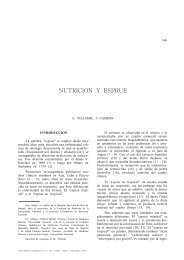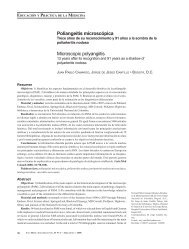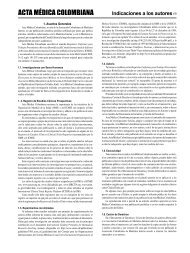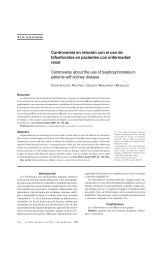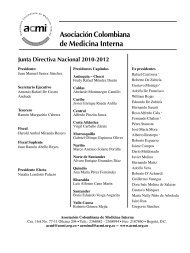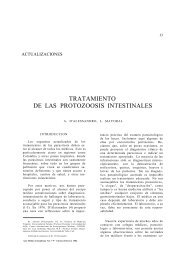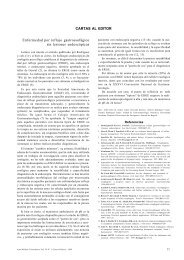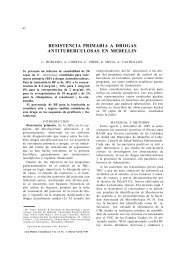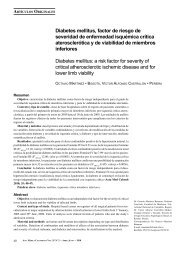ENFISEMA, BRONQUITIS Y ASMA - Acta Médica Colombiana
ENFISEMA, BRONQUITIS Y ASMA - Acta Médica Colombiana
ENFISEMA, BRONQUITIS Y ASMA - Acta Médica Colombiana
Create successful ePaper yourself
Turn your PDF publications into a flip-book with our unique Google optimized e-Paper software.
<strong>ENFISEMA</strong>, <strong>BRONQUITIS</strong> Y <strong>ASMA</strong> 317<br />
Hemos revisado los mecanismos y consecuencias<br />
de la obstrucción al flujo de aire, así<br />
como los métodos disponibles para su detección.<br />
De estos últimos hemos enfatizado la<br />
simplicidad e importancia de la curva volumen-tiempo<br />
como método accesible al internista<br />
general.<br />
BIBLIOGRAFIA<br />
1.— LEVINE G, HOUSLEY E, MACLEOD P, MACKLEM PT. Gas<br />
exchange abnormalities in mild bronchitis and asymptomatic<br />
asthma. N Engl J Med 1970; 282:1277.<br />
2.— FLETCHER CM, PETO R, TENHER CM, SPEEZER FE. The<br />
early natural history of chronic obstructive lung disease. Oxford:<br />
Oxford University Press; 1976.<br />
3.— MITCHELL RS. PETTY TL, FILLEY, GF, DART GA, SIL-<br />
VERS GW, MAISEL JC. Clinical physiologic and morphologic<br />
correlations in chronic airways obstruction. En: ORIE NGM.<br />
VANDERLENDE R, eds. Third International Symposium on<br />
bronchitis. Springfield, I11.: Charles C. Thomas; 1970.<br />
4.— TISI GM. Pulmonary physiology in clinical medicine. Williams<br />
and Wilkins, 1980.<br />
5.— BASS H. The flow volume loop: normal standards and abnormalities<br />
in chronic obstructive pulmonary disease. Chest 1973; 63:<br />
171.<br />
6.— GAZIANO D. SEATON A, OGILVIE C. Regional lung function<br />
in patients with obstructive lung disease. Br Med J 1970; 2: 330.<br />
7.— WEST JB. Ventilation/blood flow and gas exchange. Oxford:<br />
Blackwell Scientific Publications; 1977.<br />
8.— BURROWS B. NIDEN AH. BARDAY WR. KASIK JE. Chronic<br />
obstructive lung disease: clinical and physiologic findings in 1975<br />
patients and their relationship to age and sex. Am Rev Respir Dis<br />
1965; 91: 521.<br />
9.— BURROWS B. STRAUSS RH, NIDEN A. Chronic obstructive<br />
lung disease: interrelationship of pulmonary function data. Am Rev<br />
Respir Dis 1965; 91:861.<br />
10.— WAGNER PD. DANTZKER DR. DUECK R CLAUSEN JL,<br />
WEST JB. Ventilation-perfusion inequality and chronic pulmonary<br />
disease. J Clin Invest 1877; 59: 203.<br />
11.— MEISSNER P. HUGH-JONES P. Pulmonary function in bronchial<br />
asthma. Br Med J 1968; 1:470.<br />
12.— SEADDING JG. Principles of definition in medicine with special<br />
reference to chronic bronchitis and emphysema. Lancet 1959; 1:<br />
323.<br />
13.— KNUDSON RJ. SLATIN RC. LEBOURITZ MD, BURROWS B.<br />
The maximal expiratory flow-volume curve: normal standards,<br />
variability, and effects of age. Am Rev Respir Dis 1976; 113: 587.<br />
14.— ANTHONISON NR, BASS H, ORIOL A, PLACE REG, BATES<br />
DV. Regional lung function in patients with chronic bronchitis.<br />
Clin Sci 1968; 35: 495.<br />
15.— MEAD J, TURNER JM. MACKLEM PT, LITTLE JB. Significance<br />
of the relationship between lung recoil and maximum expiratory<br />
flow. J Appl Physiol 1967; 22: 95.<br />
16.— DAWSON A. Reproducibility of Spirometrie measurements in<br />
normal subjets. Am Rev Respir Dis 1966; 93: 263.<br />
17.— MCCARTHY DS. SPENCER R. GREENE R, MILIC-EMILI J.<br />
Measurement of closing volume as a simple and sensitive test for<br />
early detection of small airwall disease. Am J Med 1972; 52: 747.<br />
18.— McFADDEN ER Jr., LENDEN DA. A reduction in maximum<br />
midexpiratory flow rate: a Spirometrie manifestation of small airway<br />
disease. Am J Med 1972; 52: 725.<br />
19.— MACLEM PT. Workshop screening programs for early diagnosis<br />
of airway obstruction. Am Rev Respir Dis 1974; 109: 567.<br />
Dr. Carlos Enrique Salgado Tovar: Auxiliar de Cátedra, Departamento<br />
de Medicina Interna, Facultad de Medicina, Universidad del<br />
Valle, Cali.<br />
ASPECTOS INMUNOLOGICOS DEL <strong>ASMA</strong><br />
Aunque son múltiples los factores que<br />
pueden desencadenar una crisis de asma, infecciosos,<br />
sicológicos, farmacológicos e inmunológicos,<br />
el o los trastornos básicos que<br />
hacen que un individuo responda en esta forma<br />
inapropiada no están completamente<br />
comprendidos. Hoy, sin embargo, reconocemos<br />
a la hiperreactividad bronquial como el<br />
fenómeno predominante, no importa cuál sea<br />
el factor desencadenante (1). Esta hiperreactividad<br />
es una manifestación de hiperactividad<br />
vagal, por exceso de estimulación a<br />
nivel de la mucosa bronquial de receptores<br />
vagales periféricos denominados de irritación,<br />
que constituyen la vía aferente del<br />
<strong>Acta</strong> Med. Col. Vol. 7 N° 5. 1982<br />
F. MONTOYA<br />
reflejo que se encarga de mantener el tono<br />
bronquial (2). Se desconoce si esta hiperreflexia<br />
vagal es un fenómeno primario que<br />
traduce un trastorno neurológico de base o un<br />
proceso secundario a estados inflamatorios de<br />
la misma mucosa (3). Sabemos, no obstante,<br />
que los individuos normales pueden presentar<br />
hiperreactividad bronquial; por ejemplo: después<br />
de infecciones virales del tracto respiratorio<br />
superior, la hiperreactividad se mantiene<br />
hasta por 7 días luego de desaparecer el<br />
proceso infeccioso. Trabajadores de la industria<br />
de plásticos pueden exhibir el mismo<br />
fenómeno después de la exposición al diisocianato<br />
y persistirles hasta por 6 semanas<br />
después de abandonar la empresa.



